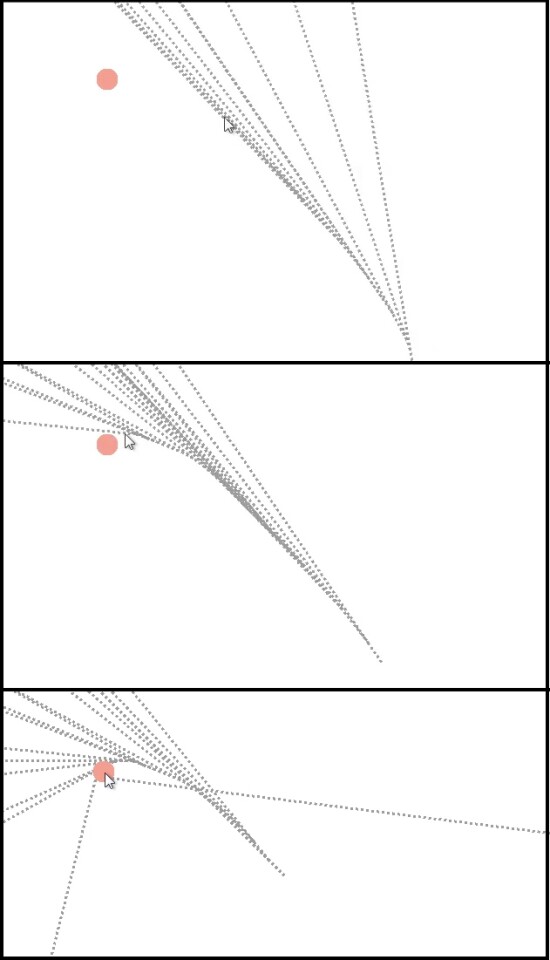For many people with motor disabilities, the task of precisely moving a mouse cursor around a screen can be incredibly frustrating. While controlling a mouse cursor with the power of thought looks likely to be possible in the not too distant future, researchers at the University of Washington's (UW) AIM Research Group have created two mouse cursors designed to make homing in on onscreen targets much easier. Neither requires additional computer hardware and all the researchers are hoping for in return for the freely downloadable software is some user feedback.
Pointing Magnifier
The first mouse cursor is similar to existing screen magnifiers that have been around for a many years. While screen magnifiers that enlarge the area surrounding the mouse cursor are great for the visually impaired, they only affect the size of the screen pixels. By enlarging not only the visual but also the motor space, the UW team's Pointing Magnifier makes it easier for users to hit their target by reducing the need for fine, precise pointing.

To use the Pointing Magnifier the cursor is first placed in the general area of the target and clicks. The software then magnifies everything in a circular area under the cursor until it fills the screen. The user then moves the cursor directly over the intended target and clicks a second time. Although the Pointing Magnifier requires two clicks to make a selection, the researchers say that this is much easier to use than a conventional mouse, which can take many clicks to connect with the target.
The Pointing Magnifier software allows users to customize the color, transparency level, magnification factor, and area cursor size. It can also be enabled and disabled via keyboard shortcuts.
Angle Mouse
The Angle Mouse uses a different method to achieve the same results. It relies on the fact that reaching a target generally consists of two steps. There is an initial ballistic movement where the cursor blasts towards the target, followed by a second, corrective movement that puts the cursor directly over the target. For motor-impaired users the first step is not so much of a problem, but the second corrective step with its need for greater motor precision can pose problems. One solution is to slow the cursor down as it nears a target, but it isn't always easy for the system to know what the user intends to target. This can cause the equally frustrating result of slowing the cursor down when it's nowhere near the intended target. To overcome these issues the Angle Mouse relies on the cursor's angle of movement.
During the initial movement towards the target, the spread of movement angles, even for people with motor impairments, tends to be narrow. However, on the second, corrective movement, the movement angles diverge sharply. This triggers the software to slow the cursor and enlarges the motor space to make the target easier to home in on. And the more trouble a user has, the larger the target will be made in motor space, without changing the visual appearance of the target.

UW researcher Jacob Wobbrock likens the Angle Mouse to a racecar. "On a straightaway, when the path is open, the car whips along, but in a tight corner, the car slows and makes a series of precise corrections, ensuring its accuracy."
A study of 16 people, half of whom had motor impairments, found that the Angle Mouse improved motor-impaired performance by 10 percent over the regular Windows default mouse and 11 percent over sticky icons, which slows the cursor down once it is inside a target. The Pointing Magnifier, on the other hand, was found to let users acquire targets, even small ones, 23 percent faster than normal.
"Pointing is an essential part of using a computer, but it can be quite difficult and time consuming if dexterity is a problem," Wobbrock said. "Even shaving one second off each time a person points may save hours over the course of a year."
Wobbrock suggests that users put both the Pointing Magnifier and Angle Mouse to the test before deciding which they prefer. Both are only available for Windows systems and are freely downloadable from the University of Washington AIM Research Group.
The Pointing Magnifier work at UW was funded by the National Science Foundation and the Natural Sciences and Engineering Research Council of Canada, while the Angle Mouse work was supported by Microsoft Research, Intel Research and the National Science Foundation.






